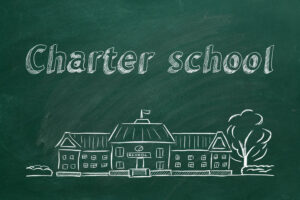The Pros & Cons of Teaching at a Charter School
You Can’t Have Too Many Options When it Comes to Education
By Brian Miller, Secondary Principal
 Charter schools are just like public schools, just with more freedom and less money. Or so the common understanding goes. But is it true? President Obama didn’t think so. Neither did Betsy Devos, the former Secretary of Education appointed by President Trump. They believed charter schools were much more, that they were “incubators of innovation” and another “very valid choice.” President George W. Bush believed charters schools broke up “the monopoly of one-size-fits- all education” by providing parents a valid second option.
Charter schools are just like public schools, just with more freedom and less money. Or so the common understanding goes. But is it true? President Obama didn’t think so. Neither did Betsy Devos, the former Secretary of Education appointed by President Trump. They believed charter schools were much more, that they were “incubators of innovation” and another “very valid choice.” President George W. Bush believed charters schools broke up “the monopoly of one-size-fits- all education” by providing parents a valid second option.
And they do. Charter schools do all of those things. Or at least they can do all of those things. The problem is, at times, they don’t. Which only fans the flames of division between public and charter schools.
The differences between charter and public schools isn’t always cut and dry, but there are some clear distinctions. What is cut and dry, however, is that charter schools challenge public schools by providing students, parents, and teachers more than one schooling option.
But what are those options? Are the valid and real options? And are those options good for teachers, students, and their local communities?
To answer those questions, we need to understand a bit more about charter schools.
Charter Schools: A Brief Overview
 Charter schools are not all that new to the world of education, they’ve just been quiet. With almost 50 years of experience, they are not a new fad that will come and go, but rather, a valid option for both parents and teachers. To understand why they are here and where they are going, we must first understand why they exist and why they just might be a better option for parents and their children.
Charter schools are not all that new to the world of education, they’ve just been quiet. With almost 50 years of experience, they are not a new fad that will come and go, but rather, a valid option for both parents and teachers. To understand why they are here and where they are going, we must first understand why they exist and why they just might be a better option for parents and their children.
1. Why do charter schools exist?
Charter schools exist to give parents choice in their child’s education. With public schools often falling short and private schools costing too much for many average Americans, charter schools provided a valid secondary option. From the beginning, their goal has been to provide a more holistic and quality education.
According to Public Charter Schools Insider, charter schools originated in the 1970s by a New England educator named Ray Budde. The idea “was for groups of teachers to set up contracts or ‘charters’ with their local school board to discover new approaches and ideas in the field of education.” From the beginning, the purpose of a charter school was to be a place where teachers and students could engage in progressive ideas and pursue educational freedoms in hopes of achieving higher rates of student success.
Throughout the years, charter schools have continued to garner more and more support, from local communities to American presidents. Today, there are more than 5,700 charter schools throughout the country.
2. Why do parents choose charter schools?
There are several reasons why parents choose charter schools, including but not limited to:
- They’re an affordable alternative to private schools
- They provide a diverse student population
- They are more innovative and student-centered in their teaching practices
- They are not bound by state and federal regulations
- They boast a more rigorous curriculum
- They provide smaller class sizes
On the surface, these reasons seem idealistic and obvious reasons for parents to choose charter schools over public or private education. The problem is, they are not always true. As more and more studies begin to surface on the efficiency and reliability of charter school proclamations, the findings are inconclusive. Some charter schools do in fact provide the type of education parents are looking for, but many do not.
But whether the claims and ideas of charter schools is reliable isn’t really important. What is important is that parents and students are provided an option, and if their local charter school provides the type of education and environment needed for their child, they should have a right to choose that option.
3. How do charter schools pick their students?
Unlike public schools, charter schools do not have to take in students from an assigned area. Nor are parents restricted to the school district their home is located in. Parents and students are free to attend any charter school, no matter their residence. If, however, the enrollment exceeds the school’s space or teacher-to-student ratio, a charter can pick which students are allowed to attend. This is often done through a random lottery, but not always.
Like public schools, charter schools are held accountable by their test scores. It is therefore advantageous for them to deny students with lower test scores and pursue students with higher scores.
To determine which students are really serious about their education, charter schools have begun requiring students to walk through a college application-like process.
In an article published by Stephanie Simon entitled, “Special Report: Class Struggle – How Charter Schools Get Students They Want,” she wrote “Students may be asked to submit a 15-page typed research paper, an original short story, or a handwritten essay on the historical figure they would most like to meet. There are interviews. Exams. And pages of questions for parents to answer, including: How do you intend to help this school if we admit your son or daughter?”
Charter schools are not supposed to have selective admissions, but it is becoming more of a common practice and narrative as test scores and college admission rates are increasingly becoming the center of education.
Charter Schools vs Public Schools: As a Teacher, what are The Pros and Cons?
 Whether you are a seasoned teacher or just starting out on your professional journey, you have no doubt heard of the charter vs public school debate. As a teacher, it is important to know a few key difference for they will have a large impact not only on your day-to-day teaching, they will impact your career and even future retirement. As a teacher, here are three things to consider:
Whether you are a seasoned teacher or just starting out on your professional journey, you have no doubt heard of the charter vs public school debate. As a teacher, it is important to know a few key difference for they will have a large impact not only on your day-to-day teaching, they will impact your career and even future retirement. As a teacher, here are three things to consider:
1. Are charter schools good for teachers?
One of the greatest benefits of teaching in a charter school is autonomy. Charter schools boast that because they have less government restrictions, their teachers are free to explore a larger variety of content areas, assessment types, and teaching strategies. And because charter schools advertise themselves as innovative schools with state-of-the-art teaching strategies, teachers in a charter school are often times encouraged to experiment in their classroom practices, allowing for student-centered autonomous teaching.
From a purely teaching perspective, charter schools can be good for teachers. But as every aging adult would say and Daniel Pink would affirm, money isn’t everything. In his New York Times Best Seller, Drive: The Surprising Truth About What Motivates Us, in order for people to perform at their best they need to be paid enough that money isn’t an issue. If they aren’t paid enough they are no longer fully focused on their jobs. They’re focused on their bills.
Teachers in charter schools can help increase their pay by pursuing and earning a master’s degree in education. Just like in public schools, teachers who earn higher degrees move up the pay scale. And the faster a teacher can earn their higher education, the more the payout will be and will provide a teacher the opportunity of the benefits of working at a charter school. The difficulty, of course, is paying for more classes while potentially earning less money.
2. What are the disadvantages of a charter school?
The greatest disadvantage for teachers in a charter schools is pay. According to professional staffing and recruiting firm, Perennial Resources International, the average public school teacher earns just over $53,000 per year, almost $10,000 more per year than the average charter school teacher who earns just $44,000.
Another disadvantage is time. Charter school teachers also tend to have longer contract days, averaging 210 days as compared to public school’s 180 days. As for benefits, many charter schools don’t have the money to offer competitive benefit packages, often do not participate in a retirement program, or only offer health insurance for their teachers, not their whole families. When it comes to teacher pay and financial security, public schools can offer more than the traditional charter school.
A third disadvantage for teachers in charter schools is that many charter schools have restrictions on unions for teachers. This, according to Perennial Resources International, can not only make it difficult for teachers to negotiate teacher raises, it can also bring roadblocks to other niceties such as student load reimbursement.
3. Who pays charter teachers?
Like public schools, charter schools receive state and local money based upon their student enrollment. They also receive money from the federal government to aid in their special education services and are able to apply for federal grants. Which means, like public school teachers, the local community and their taxes pay a charter school’s teacher salary.
Charter schools also raise additional money through private donations. According to Education Week, “Philanthropy has been a major force in the expansion of charter schools in urban areas serving low-income students.” And this is where money and the profit status of charter schools gets confusing for, “although the schools themselves are not-for-profit, they may contract with a for-profit company to manage some or much of the school,” according to Education Week. Why this is a potential problem is because large donors can suddenly have a larger input into the happenings of a charter school. From where the money is spent to even who is hired, charter schools that are reliant upon large donors may feel the pressure to cater to the money and not what’s best for the school.
The pros and cons of charter schools are as varied as the opinions about them. There is no conclusive evidence as to which is better, private, public, or charter, but there is a continued and growing support for them. Whether it be because they really do achieve all that they advertise, or if because they are simply another option for parents, students, and teachers no one really knows. What we do know is that they aren’t going away anytime soon, if ever. And the longer they stay the more they will continue to mold and grow and challenge public education. Which, in the end, probably isn’t a bad thing.
